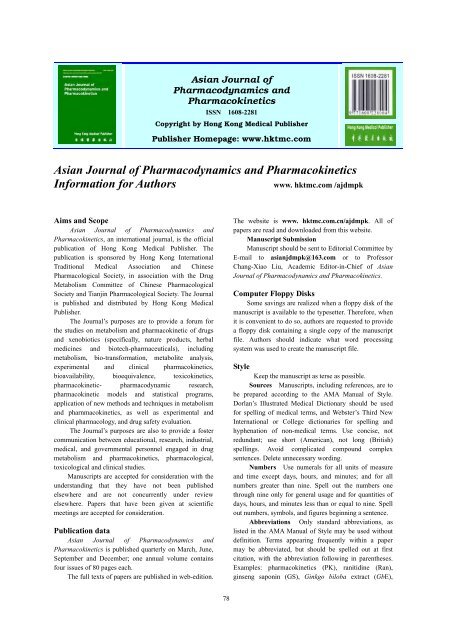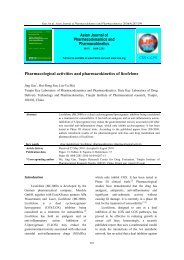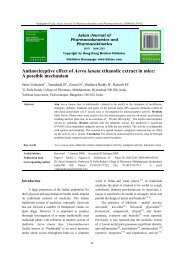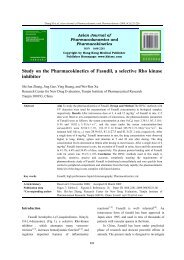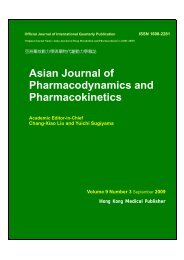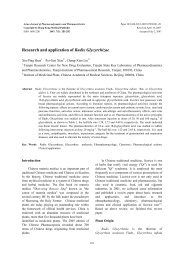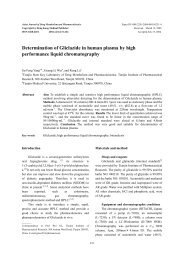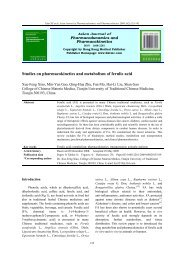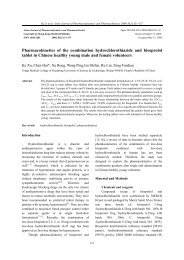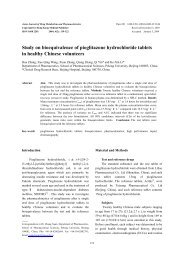Asian Journal of Pharmacodynamics and Pharmacokinetics ...
Asian Journal of Pharmacodynamics and Pharmacokinetics ...
Asian Journal of Pharmacodynamics and Pharmacokinetics ...
You also want an ePaper? Increase the reach of your titles
YUMPU automatically turns print PDFs into web optimized ePapers that Google loves.
<strong>Asian</strong> <strong>Journal</strong> <strong>of</strong><br />
<strong>Pharmacodynamics</strong> <strong>and</strong><br />
<strong>Pharmacokinetics</strong><br />
ISSN 1608-2281<br />
Copyright by Hong Kong Medical Publisher<br />
Publisher Homepage: www.hktmc.com<br />
<strong>Asian</strong> <strong>Journal</strong> <strong>of</strong> <strong>Pharmacodynamics</strong> <strong>and</strong> <strong>Pharmacokinetics</strong><br />
Information for Authors<br />
www. hktmc.com /ajdmpk<br />
Aims <strong>and</strong> Scope<br />
<strong>Asian</strong> <strong>Journal</strong> <strong>of</strong> <strong>Pharmacodynamics</strong> <strong>and</strong><br />
<strong>Pharmacokinetics</strong>, an international journal, is the <strong>of</strong>ficial<br />
publication <strong>of</strong> Hong Kong Medical Publisher. The<br />
publication is sponsored by Hong Kong International<br />
Traditional Medical Association <strong>and</strong> Chinese<br />
Pharmacological Society, in association with the Drug<br />
Metabolism Committee <strong>of</strong> Chinese Pharmacological<br />
Society <strong>and</strong> Tianjin Pharmacological Society. The <strong>Journal</strong><br />
is published <strong>and</strong> distributed by Hong Kong Medical<br />
Publisher.<br />
The <strong>Journal</strong>’s purposes are to provide a forum for<br />
the studies on metabolism <strong>and</strong> pharmacokinetic <strong>of</strong> drugs<br />
<strong>and</strong> xenobiotics (specifically, nature products, herbal<br />
medicines <strong>and</strong> biotech-pharmaceuticals), including<br />
metabolism, bio-transformation, metabolite analysis,<br />
experimental <strong>and</strong> clinical pharmacokinetics,<br />
bioavailability, bioequivalence, toxicokinetics,<br />
pharmacokinetic- pharmacodynamic research,<br />
pharmacokinetic models <strong>and</strong> statistical programs,<br />
application <strong>of</strong> new methods <strong>and</strong> techniques in metabolism<br />
<strong>and</strong> pharnmacokinetics, as well as experimental <strong>and</strong><br />
clinical pharmacology, <strong>and</strong> drug safety evaluation.<br />
The <strong>Journal</strong>’s purposes are also to provide a foster<br />
communication between educational, research, industrial,<br />
medical, <strong>and</strong> governmental personnel engaged in drug<br />
metabolism <strong>and</strong> pharmacokinetics, pharmacological,<br />
toxicological <strong>and</strong> clinical studies.<br />
Manuscripts are accepted for consideration with the<br />
underst<strong>and</strong>ing that they have not been published<br />
elsewhere <strong>and</strong> are not concurrently under review<br />
elsewhere. Papers that have been given at scientific<br />
meetings are accepted for consideration.<br />
Publication data<br />
<strong>Asian</strong> <strong>Journal</strong> <strong>of</strong> <strong>Pharmacodynamics</strong> <strong>and</strong><br />
<strong>Pharmacokinetics</strong> is published quarterly on March, June,<br />
September <strong>and</strong> December; one annual volume contains<br />
four issues <strong>of</strong> 80 pages each.<br />
The full texts <strong>of</strong> papers are published in web-edition.<br />
The website is www. hktmc.com.cn/ajdmpk. All <strong>of</strong><br />
papers are read <strong>and</strong> downloaded from this website.<br />
Manuscript Submission<br />
Manuscript should be sent to Editorial Committee by<br />
E-mail to asianjdmpk@163.com or to Pr<strong>of</strong>essor<br />
Chang-Xiao Liu, Academic Editor-in-Chief <strong>of</strong> <strong>Asian</strong><br />
<strong>Journal</strong> <strong>of</strong> <strong>Pharmacodynamics</strong> <strong>and</strong> <strong>Pharmacokinetics</strong>.<br />
Computer Floppy Disks<br />
Some savings are realized when a floppy disk <strong>of</strong> the<br />
manuscript is available to the typesetter. Therefore, when<br />
it is convenient to do so, authors are requested to provide<br />
a floppy disk containing a single copy <strong>of</strong> the manuscript<br />
file. Authors should indicate what word processing<br />
system was used to create the manuscript file.<br />
Style<br />
Keep the manuscript as terse as possible.<br />
Sources Manuscripts, including references, are to<br />
be prepared according to the AMA Manual <strong>of</strong> Style.<br />
Dorlan’s Illustrated Medical Dictionary should be used<br />
for spelling <strong>of</strong> medical terms, <strong>and</strong> Webster’s Third New<br />
International or College dictionaries for spelling <strong>and</strong><br />
hyphenation <strong>of</strong> non-medical terms. Use concise, not<br />
redundant; use short (American), not long (British)<br />
spellings. Avoid complicated compound complex<br />
sentences. Delete unnecessary wording.<br />
Numbers Use numerals for all units <strong>of</strong> measure<br />
<strong>and</strong> time except days, hours, <strong>and</strong> minutes; <strong>and</strong> for all<br />
numbers greater than nine. Spell out the numbers one<br />
through nine only for general usage <strong>and</strong> for quantities <strong>of</strong><br />
days, hours, <strong>and</strong> minutes less than or equal to nine. Spell<br />
out numbers, symbols, <strong>and</strong> figures beginning a sentence.<br />
Abbreviations Only st<strong>and</strong>ard abbreviations, as<br />
listed in the AMA Manual <strong>of</strong> Style may be used without<br />
definition. Terms appearing frequently within a paper<br />
may be abbreviated, but should be spelled out at first<br />
citation, with the abbreviation following in parentheses.<br />
Examples: pharmacokinetics (PK), ranitidine (Ran),<br />
ginseng saponin (GS), Ginkgo biloba extract (GbE),<br />
78
volume <strong>of</strong> distribution (Vd), Calcium calmodilin<br />
dependent protein kinase (CCDPK).<br />
Manuscript Preparation<br />
Type the manuscript on white bond paper (A4) with<br />
broad margins. Use double spacing through out. Organize<br />
the manuscript in the order indicated below, with the page<br />
number typed in the upper right-h<strong>and</strong> corner <strong>of</strong> each page.<br />
Title Page Page 1 should include: (1) the title <strong>of</strong><br />
the article (80 characters maximum); (2) full name(s) <strong>of</strong><br />
author(s); (3) affiliations (job title, department,<br />
institution,city, <strong>and</strong> state or country) indicating which<br />
authors are associated with which affiliations; <strong>and</strong> (4)<br />
Footnotes may include the name <strong>and</strong> address <strong>of</strong> the author<br />
to whom reprint requests are to be sent, <strong>and</strong><br />
correspondence to which author, phone, Fax, <strong>and</strong> E-mail,<br />
as well as source <strong>of</strong> financial support..<br />
Abstract <strong>and</strong> Key Words Page 2 should include<br />
the title <strong>of</strong> the article followed by the abstract, which<br />
should be about 200 words. The abstract should<br />
summarize the main points <strong>of</strong> the article. The abstract in<br />
structured form consists <strong>of</strong> Aim (the purpose <strong>of</strong> the study),<br />
Methods (basic proedures), Results (main findings with<br />
main data) <strong>and</strong> Conclusions. Following the abstract, list<br />
4-8 key words for indexing.<br />
Text<br />
Papers should be organized in the following format:<br />
Introduction, Materials <strong>and</strong> methods, Results, discussion,<br />
<strong>and</strong> references.<br />
Introduction<br />
summarizes the rationale <strong>and</strong> gives a concise<br />
background. Use references to provide the most salient<br />
background rather than an exhaustive review. The last<br />
sentence should state tersely your purpose to do this study.<br />
An uncommon or new compound should be identified by<br />
the chemical name <strong>and</strong> structural formula.<br />
Materials <strong>and</strong> methods<br />
Materials International Nonproprietary Names<br />
(INN) or generic names should be employed whenever<br />
possible. If necessary, the proprietary name may be added<br />
once, in parentheses. The first letter <strong>of</strong> the drug name<br />
should be small for INN or generic names, but capitalized<br />
for proprietary names. Manufacturers <strong>and</strong> specifications<br />
should be given for main drugs, chemicals, <strong>and</strong><br />
instruments. The drug administration schedule should be<br />
identified, includes dose <strong>and</strong> route <strong>of</strong> administration.<br />
Scientific name for all microorganism, plants, <strong>and</strong><br />
animals should be given. The sex, age, <strong>and</strong> actually<br />
measured body weights <strong>of</strong> tested animals or humans<br />
should be expressed as mean, st<strong>and</strong>ard deviation, <strong>and</strong><br />
total range.<br />
Methods: Offer technical information to allow the<br />
experiments to be repeated. Describe new methods or<br />
modifications <strong>and</strong> identify the unusual instruments <strong>and</strong><br />
procedures in sufficient detail. The routes <strong>of</strong><br />
administration may be abbreviated, eg, intraarterial (ia),<br />
intracerebroventricular (icv), intragastric gavage (ig),<br />
intramuscular (im), intraperitoneal (ip), intravenous (iv),<br />
per os (po), subcutaneous (sc). Dosage is expressed as per<br />
kg ( in animals).<br />
Statistical Methods: Statistical methods should be<br />
described to verify the results. Give number <strong>of</strong><br />
observations <strong>and</strong> subjects. Report losses to observations,<br />
such as dropouts from the study. Only homogeneous data<br />
can be averaged. The st<strong>and</strong>ard deviation (s) is much<br />
preferred to st<strong>and</strong>ard error (s x ).<br />
Suitable techniques should be chosen for the<br />
statistical treatments, eg, t test (group or paired<br />
comparisons), chi-squqre test, Ridit, probit, logit,<br />
regression, correlation, analysis <strong>of</strong> variance (ANOVA),<br />
analysis <strong>of</strong> covariance, etc.<br />
Effective digits are determined by the precision <strong>of</strong><br />
the measuring instruments. Do not include more digits<br />
than are justified by the accuracy <strong>of</strong> the determinations.<br />
Results<br />
Simple data may be set forth in text with no need <strong>of</strong><br />
tables or figures. Described results should be<br />
underst<strong>and</strong>able <strong>and</strong> clear. The word “significantly” should<br />
be replaced by its synonyms, if it indicates, or the p value,<br />
if it indicates statistical significance. The tables <strong>and</strong><br />
figures should be prepared according to following<br />
principles. Summarize or emphasize the results followed<br />
by tables or figures. Reserve extensive interpretations <strong>of</strong><br />
the results for the discussion section.<br />
Tables: Each table should have a brief title. Type<br />
each table on separate sheet. If the table must exceed one<br />
page, duplicate all headings on the second sheet. Number<br />
tables in the order in which they are cited in the text.<br />
Define all abbreviations <strong>and</strong> indicate the units <strong>of</strong><br />
measurement for all values. Explain all empty spaces or<br />
dashes. If data from any other source, published or<br />
unpublished, are used, obtain a permission letter for their<br />
use <strong>and</strong> cite the source in the legend.<br />
Figures: Figures should be pr<strong>of</strong>essionally drawn in<br />
black ink <strong>and</strong>, if possible, submitted as glossy,<br />
high-contrast black-<strong>and</strong>-white photographs between three<br />
<strong>and</strong> six inches in width. Letters, numbers, <strong>and</strong> symbols<br />
should be clear throughout, <strong>and</strong> should be large enough to<br />
remain legible when reduced for publication. In general,<br />
the size is height: width = 2;3. Be sure that all spelling is<br />
correct, that there are no broken letters or uneven type,<br />
<strong>and</strong> that abbreviations used are consistent with those in<br />
the text. The data for drawing the figures should be typed<br />
on separate sheets <strong>and</strong> submitted along with the figures.<br />
Quantity <strong>and</strong> unit: Physical quantity is printed in<br />
italic type. A subscript that represents a symbol for a<br />
physical quantity is printed in italic type. A solidus (/)<br />
shall not be followed by a multiplication sign or a<br />
division sign unless parentheses are inserted to avoid any<br />
ambiguity. In complicated cases negative powers or<br />
parentheses shall be used. SI units must be used.<br />
Discussion<br />
Discussion should deal with interpretations <strong>of</strong> your<br />
79
esults. Emphasize any new <strong>and</strong> important aspects <strong>and</strong><br />
relate your results to other studies. Discuss the<br />
shortcomings in your experiments. New hypotheses <strong>and</strong><br />
recommendations may be proposed when warranted.<br />
End with a brief conclusion, which ought to be linked<br />
with the goal stated in introduction.<br />
Acknowledgments<br />
Acknowledgments may briefly include (1)<br />
contributors that do not warrant authorship; (2) technical<br />
help; <strong>and</strong> (3) financial or material support.<br />
References<br />
Type references double-spaced <strong>and</strong> number them<br />
consecutively in the order in which they are first<br />
mentioned in text, not alphabetically. The references<br />
should conform to the style recommended in the AMA<br />
Manual <strong>of</strong> Style. References in text, tables, <strong>and</strong> legends<br />
are identified by Arabic numerals typed parenthetically.<br />
Authors are responsible for the accuracy <strong>and</strong><br />
completeness <strong>of</strong> the references.<br />
For journal articles, include: (1) author name(s) <strong>of</strong><br />
all authors; (2) title; (3) journal title abbreviated as it<br />
appears in the Index Medicus or spelled out if it is not<br />
listed; (4) year <strong>of</strong> publication; (5) volume number; (6)<br />
issue; <strong>and</strong> (7) inclusive page numbers.<br />
For books, list: (1) author name(s); (2) title,<br />
including number <strong>of</strong> editions; (3) chapter title if<br />
appropriate; (4) editor; (5) place <strong>of</strong> publication, publisher,<br />
<strong>and</strong> year published; (6) volume number <strong>and</strong> (7) page<br />
numbers if appropriate.<br />
For Conference proceedings <strong>and</strong> conference papers,<br />
list: (1) author name(s) <strong>of</strong> all authors; (2) title; (3) Name<br />
<strong>of</strong> Conference proceedings or Conference Paper<br />
Collection; (4) year, month, data, place (Country, city); (5)<br />
place <strong>of</strong> publication, publisher, <strong>and</strong> year published; (6)<br />
volume number <strong>and</strong> (7) inclusive page numbers.<br />
Unpublished observations <strong>and</strong> personal<br />
communications should not appear in the references.<br />
Manuscripts that have been accepted for publication but<br />
have not yet been published may appear in the references:<br />
include authors, manuscript title, <strong>and</strong> name <strong>of</strong> journal<br />
followed by “in press” in parentheses.<br />
Sample references<br />
1. Abraham BK, Adithan C, Usha Kiran P, Asad M,<br />
Koumaravelou K. Genetic polymorphism <strong>of</strong> CYP2D6 in<br />
kamataka <strong>and</strong> <strong>and</strong>hra pradesh population in india. Acta<br />
Pharmacol Sin 2000; 21: 494-8.<br />
2. Liu CX. Studies on Drug Metabolism <strong>and</strong><br />
pharmacokinetics in China. ISSX Newsletter 1990; 9(2):<br />
1-2.<br />
3. Milton AS. Prostagl<strong>and</strong>ins <strong>and</strong> fever. In: Sharma HS,<br />
Westman J, editors. Progress in brain research; v 115. Brain<br />
function in hot environment. Amsterdam: Elsevier; 1998;<br />
129-39.<br />
4. Wnag LCK. Current drug safety testing in USA.<br />
Proccedings <strong>of</strong> International Symposium on Traditional<br />
Medicines <strong>and</strong> Modren Pharmacology; 1987 May 2-4;<br />
Beijing, China. Beijing: Chinese Pharmacological Society;<br />
1987; 257-61.<br />
5. World Health Organization. Good manufacturing practices<br />
for pharmaceutical products. Annex 1. Thirty-second<br />
Report <strong>of</strong> the WHO Expert Committee on Specifications<br />
for pharmaceutical preparation. WHO Technical Report<br />
Series N.823. Geneva, Switzerl<strong>and</strong>: World Health<br />
Organization.<br />
6. Guo FK, Li YL, Wu SG. Antisense IRAK-2 oligonucleotide<br />
inhibits interleukin-1-induced nuclear factor-kB activiation<br />
in vitro. Acta Pharmacol Sin 2000; 21: in press.<br />
Editor’s Note<br />
The instruction for manuscript preparation assume<br />
certain resources are available to the author. Although<br />
compliance with these instructions will increase the<br />
probability <strong>of</strong> publication in the <strong>Journal</strong>, authors should<br />
not be discouraged in submitting manuscripts that do not<br />
completely comply with these instructions. If an author<br />
feels his/her manuscript is worthy <strong>of</strong> publication in the<br />
<strong>Journal</strong>, he/she should do as much as possible to comply,<br />
then submit it to the editor. If the editor <strong>and</strong> editorial<br />
board agree on its desirability for publication, the<br />
Editorial Office will assist in satisfying the publisher’s<br />
manuscript preparation requirements.<br />
Review <strong>and</strong> Publication Process<br />
Manuscripts are examined by the Editor <strong>and</strong> in most<br />
cases by reviewers. Decisions <strong>of</strong> the Editor are final. All<br />
material accepted for publication is subject to copyediting.<br />
Authors will receive page pro<strong>of</strong>s before publication, <strong>and</strong><br />
should answer all queries <strong>and</strong> carefully check all editorial<br />
changes at this point.<br />
The first author <strong>of</strong> each article will freely receive 4<br />
copies <strong>of</strong> the complete issue.<br />
Copyright Protection<br />
The submission <strong>of</strong> the manuscript by author means<br />
that the authors automatically agree to assign exclusive<br />
copyright to Hong Kong Medical Publisher once this<br />
manuscript is accepted for publication. The work should<br />
not be published elsewhere in any forms without written<br />
permission <strong>of</strong> the Publisher. The paper published in Hong<br />
Kong Medical Publisher is protected by copyright, which<br />
covers the translation rights <strong>and</strong> exclusive right to<br />
reproduce <strong>and</strong> distribute all <strong>of</strong> the articles published in<br />
Hong Kong Medical Publisher.<br />
80


